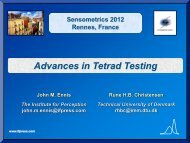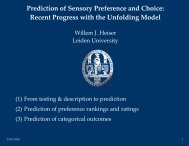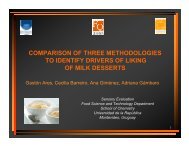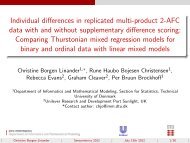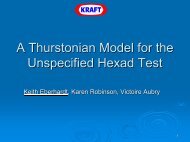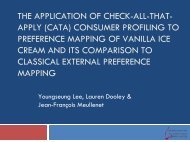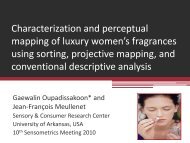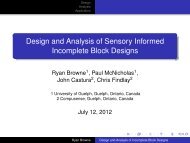The impact of Sensory Evaluation of Sound - past, present and future
The impact of Sensory Evaluation of Sound - past, present and future
The impact of Sensory Evaluation of Sound - past, present and future
You also want an ePaper? Increase the reach of your titles
YUMPU automatically turns print PDFs into web optimized ePapers that Google loves.
<strong>The</strong> Impact <strong>of</strong> <strong>Sensory</strong> <strong>Evaluation</strong> <strong>of</strong><br />
<strong>Sound</strong> - <strong>past</strong>, <strong>present</strong> <strong>and</strong> <strong>future</strong>.<br />
Sensometrix 2012, Agrocampus, Rennes, France<br />
12 July 2012<br />
Nick Zacharov<br />
nick.zacharov@genelec.com
Outline<br />
• Domains <strong>of</strong> sound<br />
• Short historical review – some key works<br />
• State t <strong>of</strong> the field<br />
• Some examples over a decade or so<br />
• Where are the st<strong>and</strong>ards<br />
• Successes / challenges <strong>and</strong> the <strong>future</strong><br />
<strong>Sensory</strong> <strong>Evaluation</strong> <strong>of</strong> <strong>Sound</strong>, Sensometrix 2012, Rennes, France
Domains <strong>of</strong> <strong>Sound</strong>
<strong>The</strong> facets <strong>of</strong> sound<br />
• Large number <strong>of</strong> facets <strong>of</strong> application below the level <strong>of</strong><br />
sound, each having their own specific needs<br />
• Three <strong>of</strong> the most common include:<br />
• Audio (reproduced sound)<br />
• Telecommunication (speech)<br />
• Product sound (noise)<br />
<strong>Sensory</strong> <strong>Evaluation</strong> <strong>of</strong> <strong>Sound</strong>, Sensometrix 2012, Rennes, France
<strong>The</strong> audio application<br />
• Is a fairly common case<br />
• How to faithfully reproduce sound<br />
• Mostly for the purposes <strong>of</strong><br />
entertainment<br />
t t<br />
• Hifi<br />
• Home <strong>The</strong>atre /<br />
surround sound<br />
• <strong>The</strong> challenge lies is defining<br />
an absolute point <strong>of</strong> reference<br />
• How a producer heard<br />
the sound<br />
• How the original was<br />
experienced in a concert<br />
hall<br />
• Focus on enjoyment<br />
<strong>Sensory</strong> <strong>Evaluation</strong> <strong>of</strong> <strong>Sound</strong>, Sensometrix 2012, Rennes, France 5
<strong>The</strong> (tele)communication challenge<br />
• At face value a trivial case<br />
• Replicate face to face<br />
conversation<br />
• Focused on<br />
communication<br />
• Speaker identification<br />
secondary<br />
• <strong>Sound</strong> quality tertiary<br />
• Other artefacts come<br />
later<br />
• Noise, distortion,<br />
etc…<br />
<strong>Sensory</strong> <strong>Evaluation</strong> <strong>of</strong> <strong>Sound</strong>, Sensometrix 2012, Rennes, France 6
Product sound<br />
• Product sound is the overall<br />
domain where the sound is a<br />
secondary, perhaps unwanted,<br />
aspect <strong>of</strong> the product<br />
• Car noise<br />
• Wind turbine noise<br />
• <strong>Sound</strong>s <strong>of</strong> white products<br />
• Vacuum cleaner,<br />
washing machine<br />
• Combination <strong>of</strong> functional<br />
sound <strong>and</strong> controlling<br />
annoyance<br />
<strong>Sensory</strong> <strong>Evaluation</strong> <strong>of</strong> <strong>Sound</strong>, Sensometrix 2012, Rennes, France 7
Focus for today<br />
Is on audio (sound reproduction) <strong>and</strong> (tele)communication<br />
applications<br />
<strong>Sensory</strong> <strong>Evaluation</strong> <strong>of</strong> <strong>Sound</strong>, Sensometrix 2012, Rennes, France 8
Short historical i overview<br />
Some key works<br />
9
Some background<br />
• Fairly well agreed that<br />
sensory science roots are<br />
in the field <strong>of</strong> food science<br />
during the 50’s<br />
• E.g. 9-point hedonic<br />
scale (Peryam <strong>and</strong><br />
Pilgrim 1957)<br />
• This has lead to the key<br />
developments in the field<br />
<strong>Sensory</strong> <strong>Evaluation</strong> <strong>of</strong> <strong>Sound</strong>, Sensometrix 2012, Rennes, France
And for sound..<br />
• Things started fairly early on<br />
• 1900 with concert halls<br />
• <strong>The</strong> question <strong>of</strong> interest was “why do concert halls sound so<br />
different” <strong>and</strong> what are the perceptual attributes that are needed<br />
for “good” acoustics<br />
<strong>Sensory</strong> <strong>Evaluation</strong> <strong>of</strong> <strong>Sound</strong>, Sensometrix 2012, Rennes, France 11
<strong>The</strong> pioneering work <strong>of</strong> Sabine<br />
• Motivation<br />
• What makes a hall sound<br />
acoustically acceptable (1900)<br />
• Sabine identified some key<br />
characteristics<br />
• Loudness<br />
• Distortion <strong>of</strong> complex sounds:<br />
interference <strong>and</strong> resonance<br />
• Confusion: reverberation,<br />
echo <strong>and</strong> extraneous sounds<br />
Wallace Clement Sabine<br />
1868‐1919<br />
<strong>The</strong> father <strong>of</strong> concert hall<br />
acoustics<br />
<strong>Sensory</strong> <strong>Evaluation</strong> <strong>of</strong> <strong>Sound</strong>, Sensometrix 2012, Rennes, France 12
Reverberation<br />
• Underst<strong>and</strong>ing the role <strong>of</strong> reverberance led to the<br />
development Sabine’s equation<br />
T = 0.161 V/A<br />
T = the reverberation time<br />
V = the room volume<br />
A = the total absorption area<br />
• And subsequently some classical concert halls<br />
• E.g. Boston Symphony Hall<br />
<strong>Sensory</strong> <strong>Evaluation</strong> <strong>of</strong> <strong>Sound</strong>, Sensometrix 2012, Rennes, France 13
<strong>The</strong> early years (1962-1975)<br />
• Focused on concert hall sound quality<br />
• Beranek (1962)<br />
• Interview based attribute development <strong>of</strong> 54 concert halls (live)<br />
8 continuous scales developed<br />
• Hawkes <strong>and</strong> Douglas (1971)<br />
• 14 provided attribute scales, in 4 halls at 4 locations (live)<br />
• Nakayama et al. (1971)<br />
• MDS analysis <strong>of</strong> a single hall, using 1-8 speakers<br />
• 3 latent dimensions interpreted<br />
• Wilkens (1975)<br />
• Binaural recording <strong>and</strong> reproduction <strong>of</strong> 6 concert halls<br />
Rated on provided 16 scales 3 latent dimensions<br />
<strong>Sensory</strong> <strong>Evaluation</strong> <strong>of</strong> <strong>Sound</strong>, Sensometrix 2012, Rennes, France 14
1975 - 1995<br />
• More concert hall studies<br />
• Schoeder (1974), Lav<strong>and</strong>ier (1989), Kahle (1995)<br />
• <strong>The</strong> start <strong>of</strong> sensory sound reproduction research<br />
• Staffeldt (1974), Gabrielsson (1974,1979), Toole (1982, 1985 1986),<br />
• <strong>The</strong> beginning <strong>of</strong> communication quality research<br />
• Voiers (1977, 1983), Quackenbush (1988)<br />
<strong>Sensory</strong> <strong>Evaluation</strong> <strong>of</strong> <strong>Sound</strong>, Sensometrix 2012, Rennes, France 15
1995 - now<br />
• Shift towards spatial sound reproduction<br />
• Both headphone <strong>and</strong> loudspeaker<br />
• Zacharov (2001), Lorho (2005, 2010), Berg & Rumsey (2006), Choisel<br />
<strong>and</strong> F. Wickelmaier (2007), Wankling (2012)<br />
• More indepth mobile telecommications focus<br />
• Mattila (2001), Wältermann (2010)<br />
• Even more on concert halls<br />
• Lokki et al (2011)<br />
• Some multimodal research<br />
• Audio-Visual perception, Audio-haptic, etc…<br />
• Other applications<br />
• Hearding aids, active noise contrpl, <strong>Sound</strong> br<strong>and</strong>ing, emotions, etc. 2006<br />
<strong>Sensory</strong> <strong>Evaluation</strong> <strong>of</strong> <strong>Sound</strong>, Sensometrix 2012, Rennes, France 16
A spa rse timeline <strong>of</strong> perceptua l eva lua tion in a udio<br />
Sabine "Reverberation: Introduction"<br />
Schroeder, "Comparative study <strong>of</strong> european concert halls"<br />
Wilkens, “Mehrdimensionale Beschreibung Subjektiver<br />
Beurteilungen der Akustik von Konzertsalen"<br />
Gabrielsson & Sjogren, “Perceived <strong>Sound</strong> Quality <strong>of</strong> <strong>Sound</strong>-<br />
Reproducing Systems”<br />
Toole, "Listening Tests-Turning Opinion into Fact"<br />
Toole, "Subjective Measurements <strong>of</strong> Loudspeaker <strong>Sound</strong><br />
Quality <strong>and</strong> Listener Performance"<br />
Quackenbush et al, "Objective Measures <strong>of</strong> Speech Quality"<br />
Letowski, "Timbre, tone colour, <strong>and</strong> sound quality"<br />
Lorho,"Individual vocabulary pr<strong>of</strong>iling <strong>of</strong> spatial enhancement<br />
system for stereo headphone reproduction"<br />
Berg & Rumsey, “Identification <strong>of</strong> Quality Attributes <strong>of</strong> Spatial<br />
Audio by Repertory Grid Technique"<br />
Choisel & Wickelmaier, “<strong>Evaluation</strong> <strong>of</strong> multichannel<br />
reproduced sound: Scaling auditory attributes underlying<br />
listener preference"<br />
Wältermann et al, “Quality Dimensions <strong>of</strong> Narrowb<strong>and</strong> <strong>and</strong><br />
Wideb<strong>and</strong> Speech Transmission"<br />
Lorho "Perceived Quality <strong>Evaluation</strong>: An Application to <strong>Sound</strong><br />
Reproduction over Headphones"<br />
Zacharov et al "<strong>The</strong> multidimensional characterization <strong>of</strong><br />
active noise cancellation headphone perception"<br />
Lokki et al "Concert hall acoustics assessment with<br />
individually elicited attributes"<br />
Bech, "Perception <strong>of</strong> Timbre <strong>of</strong> Reproduced <strong>Sound</strong> in Small<br />
Blauert & Jekosch,"A Layer Model <strong>of</strong> <strong>Sound</strong> Quality"<br />
Rooms"<br />
Bech, “Methods for subjective evaluation <strong>of</strong> spatial<br />
characteristics <strong>of</strong> sound”<br />
Zacharov &Koivuniemi, “Perceptual audio pr<strong>of</strong>iling <strong>and</strong><br />
mapping <strong>of</strong> spatial sound displays"<br />
1900 1955 1965 1975 1985 1995 2005 2015<br />
Blauert & Jekosch, “Concepts behind <strong>Sound</strong> Quality: Some<br />
Basic Considerations"<br />
Beranek, "Music, acoustics <strong>and</strong> architecture"<br />
Voiers, "Evaluating Processed Speech using the Diagnostic<br />
Rhyme Test"<br />
Gabrielsson,"Statistical treatment <strong>of</strong> data for listening tests on<br />
sound reproduction systems"<br />
Voiers, “Diagnostic Acceptability Measure for Speech<br />
Communication”<br />
Staffeldt, "Correlation Between Subjective <strong>and</strong> Objective Data<br />
for Quality Loudspeakers"<br />
Mattila, “Perceptual analysis <strong>of</strong> speech quality in mobile<br />
communications"<br />
Blauert & Jekosch, “<strong>Sound</strong>-Quality <strong>Evaluation</strong> – A Multi-<br />
Layered Problem"<br />
Lundberg et al "Perceived sound quality in a hearing aid with<br />
vented <strong>and</strong> closed earmould equalized in frequency<br />
response"<br />
Letowski, “<strong>Sound</strong>-Quality Assessment: Concepts <strong>and</strong> Criteria"<br />
Toole, Loudspeaker Measurements <strong>and</strong> <strong>The</strong>ir Relationship to<br />
Listener Preferences: Part 1 & 2<br />
<strong>Sensory</strong> <strong>Evaluation</strong> <strong>of</strong> <strong>Sound</strong>, Sensometrix 2012, Rennes, France<br />
Wankling et al "<strong>The</strong> assessment <strong>of</strong> low-frequency room<br />
acoustic parameters using descriptive analysis"<br />
Lokki et al “Concert hall acoustics assessment with sensory<br />
evaluation"<br />
Simonsen & Legarth "A Procedure for <strong>Sound</strong> Quality<br />
<strong>Evaluation</strong> <strong>of</strong> Hearing Aids"<br />
Lorho et al "eGauge - A Measure <strong>of</strong> Assessor Expertise in<br />
Audio Quality <strong>Evaluation</strong>s"<br />
Ramsgaard et al, "Application <strong>of</strong> napping® to the evaluation<br />
<strong>of</strong> digital camera zoom lens function"<br />
Bech & Zacharov "Perceptual Audio <strong>Evaluation</strong> – <strong>The</strong>ory,<br />
Method <strong>and</strong> Application"<br />
Pedersen, “<strong>The</strong> Semantic Space <strong>of</strong> <strong>Sound</strong>s, Lexicon <strong>of</strong><br />
<strong>Sound</strong>-describing Words"
State t <strong>of</strong> the field
Summary <strong>of</strong> early concert hall works (1962-1975)<br />
Lorho 2010<br />
<strong>Sensory</strong> <strong>Evaluation</strong> <strong>of</strong> <strong>Sound</strong>, Sensometrix 2012, Rennes, France 19
Concert hall attributes<br />
Sabine Beranek Wilkens Lav<strong>and</strong>ier Kahle<br />
~1900 1962 1975 1989 1995<br />
Loudness Reverberance small – large<br />
Distortion <strong>of</strong> complex sounds:<br />
interference <strong>and</strong> resonance Loudness pleasant – unpleasant<br />
Confusion: reverberation,<br />
echo <strong>and</strong> extraneous sounds Spaciousness unclear – clear<br />
Clarity<br />
Intimacy<br />
Warmth<br />
Hearing <strong>of</strong> stage<br />
s<strong>of</strong>t – hard<br />
brilliant – dull<br />
rounded – pointed<br />
vigorous – muted<br />
appealing – unappealing<br />
blunt – sharp<br />
diffuse – concentrated<br />
overbearing – reticent<br />
light – dark<br />
muddy – clear<br />
dry – reverberant<br />
weak – strong<br />
emphasized treble<br />
– treble not emphasized<br />
emphasized bass<br />
– bass not emphasized<br />
beautiful – ugly<br />
s<strong>of</strong>t – loud<br />
absent – présent<br />
puissance<br />
(absent – <strong>present</strong>) (strength)<br />
faible – énergique révébérance<br />
(weak – strong) (reverberance)<br />
brouillé – net<br />
balance générale<br />
(muddy – clear) (overall balance)<br />
lointain – proche contraste<br />
(far – near)<br />
(contrast)<br />
sec – révébérant<br />
puissance dans les graves<br />
(dry – reverberant) (low frequency strength)<br />
plat – contrasté puissance dans les aiguës<br />
(flat – contrasted) (high frequency strength)<br />
coulant – heurté pâteux<br />
(flowing – halted) (<strong>past</strong>y )<br />
dur – doux<br />
heurté<br />
(hard – s<strong>of</strong>t)<br />
(halted)<br />
neutre – intime<br />
(neutral – intimate)<br />
sec – vivant<br />
(dry – lively)<br />
creux – chaud<br />
(hollow – warm)<br />
pauvre – brillant<br />
(weak – bright)<br />
impressioni d’espace<br />
(spatial impression)<br />
largeur de la source<br />
(source width)<br />
<strong>Sensory</strong> <strong>Evaluation</strong> <strong>of</strong> <strong>Sound</strong>, Sensometrix 2012, Rennes, France 20
Staffeldt (1974)<br />
• Early application to loudspeaker sound quality<br />
• Aimed to subjectively <strong>and</strong> objectively<br />
characterize the (single) loudspeaker sound<br />
quality<br />
• Quite unique work at this time<br />
• Applied non-parametric statistics for the<br />
subjective data analysis<br />
• Bradley-Terry y model<br />
• Subjective-Objective correlation was less<br />
successful<br />
<strong>Sensory</strong> <strong>Evaluation</strong> <strong>of</strong> <strong>Sound</strong>, Sensometrix 2012, Rennes, France
Staffeldt (1974) – (2)<br />
• Subjective-Objective correlation<br />
performed on frequency response<br />
data<br />
• Grouping was logical<br />
• Overall the analysis was less<br />
successful, as only the timbral data<br />
considered<br />
<strong>Sensory</strong> <strong>Evaluation</strong> <strong>of</strong> <strong>Sound</strong>, Sensometrix 2012, Rennes, France 22
Nakayama (1971)<br />
• Early MDS based analysis<br />
• Focused upon the<br />
number <strong>of</strong> speakers<br />
required for faithful<br />
sound reproduction<br />
• Very Early steps<br />
into multichannel<br />
sound<br />
<strong>Sensory</strong> <strong>Evaluation</strong> <strong>of</strong> <strong>Sound</strong>, Sensometrix 2012, Rennes, France 23
Nakayama 1971 – (2)<br />
<strong>Sensory</strong> <strong>Evaluation</strong> <strong>of</strong> <strong>Sound</strong>, Sensometrix 2012, Rennes, France 24
Gabrielsson (1974)<br />
• Analysis <strong>of</strong> loudspeaker,<br />
headphone <strong>and</strong> hearing aid sound<br />
quality<br />
• Attribute rating<br />
• 60 selected adjectives from<br />
sound engineers,<br />
audiologists, hearing<br />
impaired subjects<br />
• Factor analysis<br />
• Similarity rating<br />
• Subsequent INDSCAL<br />
analysis<br />
<strong>Sensory</strong> <strong>Evaluation</strong> <strong>of</strong> <strong>Sound</strong>, Sensometrix 2012, Rennes, France 25
Gabrielsson (1974) – (2)<br />
• 8 latent perceptual dimensions identified:<br />
• Clearness / distinctness<br />
• Sharpness / hardness – s<strong>of</strong>tness<br />
• Brightness – darkness<br />
• Disturbing sounds<br />
• Fullness – thinness<br />
• Feeling <strong>of</strong> space<br />
• Nearness<br />
• Loudness<br />
<strong>Sensory</strong> <strong>Evaluation</strong> <strong>of</strong> <strong>Sound</strong>, Sensometrix 2012, Rennes, France 26
Toole (1985)<br />
• Further analysis on<br />
loudspeaker sound quality<br />
• Both mono <strong>and</strong> stereo<br />
systems<br />
• Based upon provided<br />
attributes<br />
• Based partially upon<br />
Gabrielsson<br />
<strong>Sensory</strong> <strong>Evaluation</strong> <strong>of</strong> <strong>Sound</strong>, Sensometrix 2012, Rennes, France 27
Toole (1985) – (2)<br />
• An early work<br />
that studied to<br />
influence <strong>of</strong><br />
assessor<br />
performance <strong>and</strong><br />
difference<br />
between panels<br />
<strong>Sensory</strong> <strong>Evaluation</strong> <strong>of</strong> <strong>Sound</strong>, Sensometrix 2012, Rennes, France 28
Letowski (1989)<br />
• A good underst<strong>and</strong>ing <strong>of</strong> the<br />
perceptual facets<br />
• Heuristic versus diagnostic<br />
• Subjective versus objective<br />
• <strong>The</strong> value <strong>of</strong> the work was<br />
not fully embraced <strong>and</strong><br />
<strong>Sensory</strong> <strong>Evaluation</strong> <strong>of</strong> <strong>Sound</strong>, Sensometrix 2012, Rennes, France
Letowski mural<br />
• First attempt <strong>of</strong> structuring<br />
perceptual attribute <strong>of</strong> sound<br />
(audio)<br />
Letowski (1989)<br />
<strong>Sensory</strong> <strong>Evaluation</strong> <strong>of</strong> <strong>Sound</strong>, Sensometrix 2012, Rennes, France 30
Zacharov (2001)<br />
• Adaption <strong>of</strong> descriptive<br />
analysis <strong>and</strong> preference<br />
mapping for audio<br />
• ADAM – audio descriptive<br />
analysis <strong>and</strong> mapping<br />
PREF FERENCE SCA ALING<br />
Naive<br />
Subjects<br />
Selection <strong>of</strong><br />
sample population<br />
<strong>and</strong> subjects<br />
Preference or<br />
dissimilarity<br />
experiment<br />
<strong>Evaluation</strong> <strong>of</strong> audio<br />
system category<br />
Preference mapping<br />
employing<br />
multivariate calibration<br />
methods<br />
(Partial least squares<br />
regression (PLS-R))<br />
DIRECT ATTRIBUTE RA ATING<br />
Experienced<br />
& Trained<br />
Subjects<br />
Selection <strong>of</strong><br />
subjects<br />
(Generalised<br />
listener<br />
selection (GLS))<br />
Development <strong>of</strong><br />
descriptive<br />
language & direct<br />
attribute scales<br />
Development <strong>of</strong><br />
training samples<br />
Direct attribute<br />
rating <strong>of</strong> all stimuli<br />
Analysis <strong>of</strong> structure<br />
(PCA & ANOVA)<br />
Coorelation analysis<br />
<strong>of</strong> attribute scales<br />
Analysis <strong>of</strong> structure<br />
(PCA & ANOVA)<br />
Relational<br />
structure <strong>of</strong><br />
direct attributes<br />
& preference<br />
space<br />
<strong>Evaluation</strong> <strong>of</strong><br />
unidimensionality <strong>of</strong><br />
direct attribute<br />
scales<br />
Underlying<br />
structure <strong>of</strong><br />
preference<br />
data<br />
Development <strong>of</strong><br />
predictive<br />
multivariate<br />
regression model<br />
<strong>of</strong> subjective<br />
preference<br />
<strong>Sensory</strong> <strong>Evaluation</strong> <strong>of</strong> <strong>Sound</strong>, Sensometrix 2012, Rennes, France 31
Zacharov (2001) – (2)<br />
• Descriptive analysis <strong>and</strong><br />
external preference<br />
mapping <strong>of</strong> spatial sound<br />
reproduction systems<br />
• 104 stimuli<br />
• Traditional attribute<br />
development<br />
• 12 attributes<br />
• 8 spatial<br />
• 4 timbral<br />
<strong>Sensory</strong> <strong>Evaluation</strong> <strong>of</strong> <strong>Sound</strong>, Sensometrix 2012, Rennes, France 32
Zacharov (2001) – (3)<br />
• Preference mapping performed<br />
using PLS-R1 model<br />
• Eliptical model found best<br />
suited<br />
• Explained variance: 71% <strong>of</strong><br />
preference data<br />
• Subjects are not in complete<br />
agreement – several<br />
“outliers”<br />
• Four principle components<br />
required<br />
• Contributions: 53%,<br />
10%, 6%, 2%<br />
<strong>Sensory</strong> <strong>Evaluation</strong> <strong>of</strong> <strong>Sound</strong>, Sensometrix 2012, Rennes, France 33
Nr. Processing Symb. Nr. Processing Symb.<br />
Mattila (2001)<br />
1<br />
2<br />
3<br />
L<strong>and</strong> line phone to mobile phone<br />
transmission, GSM-EFR<br />
L<strong>and</strong> line phone to mobile phone<br />
transmission, GSM-HR<br />
Mobile phone to mobile phone<br />
transmission, GSM-EFR<br />
LME 23<br />
LMH 24<br />
MME 25<br />
GSM-EFR <strong>and</strong> transmission<br />
channel errors (C/I = 7 dB)<br />
GSM-EFR <strong>and</strong> transmission<br />
channel errors (C/I = 4 dB)<br />
GSM-EFR <strong>and</strong> transmission<br />
channel errors (C/I = 3-15 dB)<br />
ES2<br />
ES3<br />
DH3<br />
4<br />
Mobile phone to mobile phone<br />
transmission, GSM-HR<br />
MMH 26<br />
GSM-HR <strong>and</strong> transmission<br />
channel errors (C/I = 7 dB)<br />
HS2<br />
• Large scale sensory<br />
evaluation <strong>of</strong> digital mobile<br />
phone sound quality<br />
• Large number <strong>of</strong> methods<br />
applied<br />
• Interal / external<br />
preference mapping<br />
• Large stimulus set<br />
• Large data sets<br />
5<br />
6<br />
L<strong>and</strong> line phone to mobile phone<br />
transmission, GSM-EFR, HATS<br />
L<strong>and</strong> line phone to mobile phone<br />
transmission, GSM-HR, HATS<br />
VTE 27 GSM-EFR, muting <strong>of</strong> lost frames EMT<br />
VTH 28 Transducer TRD<br />
7 PCM, ITU G.711 PCM 29 Wideb<strong>and</strong> additive noise GNS<br />
8 ADPCM, ITU G.726 ADP 30 Narrow b<strong>and</strong> additive noise NBN<br />
9 LD-CELP, ITU G.728 LDC 31 Addition <strong>of</strong> echo ECH<br />
10 GSM-FR, ETSI GSM 06.10 FR 32 Clipping CLP<br />
11 GSM-HR, ETSI GSM 06.20 HR 33 Center clipping CCL<br />
12 GSM-EFR, ETSI GSM 06.60 EFR 34 Highpass filtering HP<br />
13 EVRC, TIA IS-127 EVR 35 Low pass filtering LP<br />
14 TETRA, TETRA 06.20 TRA 36 B<strong>and</strong>pass filtering BP<br />
15 PDC-HR, RCR PDC 37 Angular pole distortion APD<br />
16 U-ALWE (noise suppression) UAW 38 Radial pole distortion RPD<br />
17 UDRC (dynamic range control) DRC 39 Pole distortion POD<br />
18 U-ALWE <strong>and</strong> GSM-EFR EAW 40<br />
Narrow b<strong>and</strong> frequency<br />
distortion<br />
19 U-ALWE <strong>and</strong> GSM-HR HAW 41 No Processing ORG<br />
20<br />
21<br />
GSM-EFR <strong>and</strong> GSM-EFR<br />
(t<strong>and</strong>em connection)<br />
GSM-HR <strong>and</strong> GSM-HR<br />
(t<strong>and</strong>em connection)<br />
NBD<br />
ETD 42 No Processing (SNR = 5 dB) OR5<br />
HTD 43<br />
GSM-HR, ETSI GSM 06.20<br />
(SNR = 5 dB)<br />
EF5<br />
22 GSM-EFR w ith DTX EDX 44<br />
GSM-EFR, ETSI GSM 06.60<br />
(SNR = 5 dB)<br />
HR5<br />
<strong>Sensory</strong> <strong>Evaluation</strong> <strong>of</strong> <strong>Sound</strong>, Sensometrix 2012, Rennes, France 34
Mattila (2001) - (2)<br />
Nr. Attribute in Finnish Attribute in English<br />
Speech 1 kireä / pingottunut tense / sharp<br />
2 tumma - kirkas dark - bright<br />
3 konemainen / mekaaninen mechanic<br />
4 metallinen metallic<br />
• 14 subjects<br />
• Language develop required ~60 hrs<br />
• 14000 words elicited<br />
• 21 attributes <strong>and</strong> scaled defined<br />
•Speech quality is one group<br />
•Background noise forms a second<br />
5 nasaalinen / inisevä nasal / w hining<br />
6 selkeä - puuroutuva clear - muffled<br />
7 ehjä - rikkonainen / katkonainen smooth - interrupted<br />
8 käheä - karhea - rosoinen rough<br />
9 särisevä rustling<br />
10 särähtelevä / rasahteleva (frekvenssi) scratching (frequency)<br />
11 särähtelevä / rasahteleva (voimakkuus) scratching (intensity)<br />
12 avoin - etäinen / tukahtunut open - distant<br />
group<br />
13 humiseva humming<br />
Background<br />
noise<br />
14 kitisevä creaking<br />
15 kohiseva noisy<br />
16 matala - korkea (taajuus) low - high (frequency content)<br />
17 kupliva (frekvenssi) bubbling (frequency)<br />
18 suhiseva hissing<br />
19 poriseva boiling<br />
20 ritisevä crackling<br />
21 tasainen - vaihteleva - ryöpsähtelevä steady - fluctuating<br />
<strong>Sensory</strong> <strong>Evaluation</strong> <strong>of</strong> <strong>Sound</strong>, Sensometrix 2012, Rennes, France 35
Mattila (2001) – (3)<br />
• Preference mapping performed using<br />
PLS-R1 model<br />
• Vector model found best suited<br />
• Explained variance: 96% <strong>of</strong><br />
preference data<br />
• 92% correlation between<br />
measured <strong>and</strong> modelled data<br />
• Subjects tended to be broadly<br />
grouped<br />
<strong>Sensory</strong> <strong>Evaluation</strong> <strong>of</strong> <strong>Sound</strong>, Sensometrix 2012, Rennes, France 36
Lorho (2005-2010)<br />
<strong>Sensory</strong> <strong>Evaluation</strong> <strong>of</strong> <strong>Sound</strong>, Sensometrix 2012, Rennes, France 37
Lorho (2005-2010)<br />
• Focused on headphone sound reproduction<br />
• Applied <strong>and</strong> adapted a large number <strong>of</strong> techniques<br />
• Consensus vocabulary development (CVP)<br />
• Extension <strong>of</strong> ADAM<br />
• Individual vocabulary development (IVP)<br />
• Continuation <strong>of</strong> Flash pr<strong>of</strong>iling, etc.<br />
• Indepth comparison on the two methods <strong>and</strong> their performance<br />
• Deep underst<strong>and</strong>ing <strong>of</strong> headphone sound quality<br />
<strong>Sensory</strong> <strong>Evaluation</strong> <strong>of</strong> <strong>Sound</strong>, Sensometrix 2012, Rennes, France 38
Lorho (2005-2010) – (2)<br />
<strong>Sensory</strong> <strong>Evaluation</strong> <strong>of</strong> <strong>Sound</strong>, Sensometrix 2012, Rennes, France 39
Lorho (2005-2010) – (3)<br />
<strong>Sensory</strong> <strong>Evaluation</strong> <strong>of</strong> <strong>Sound</strong>, Sensometrix 2012, Rennes, France 40
Lorho (2005-2010) – (4)<br />
Parafac 2 structure<br />
<strong>Sensory</strong> <strong>Evaluation</strong> <strong>of</strong> <strong>Sound</strong>, Sensometrix 2012, Rennes, France
Lorho (2005-2010) – (4)<br />
PCA analysis <strong>of</strong> the GPA<br />
average configuration<br />
<strong>Sensory</strong> <strong>Evaluation</strong> <strong>of</strong> <strong>Sound</strong>, Sensometrix 2012, Rennes, France 42
Lokki (2011)<br />
• Latest <strong>and</strong> most definitive<br />
concert hall acoustic study<br />
• Fairly soon the conert hall<br />
will be understood<br />
• Comparison <strong>of</strong> multiple halls<br />
at multiple l positions<br />
• Using a virtual orchestra<br />
• IVP approach<br />
• (H)MFA analysis<br />
• Also for metric<br />
objective mapping<br />
<strong>Sensory</strong> <strong>Evaluation</strong> <strong>of</strong> <strong>Sound</strong>, Sensometrix 2012, Rennes, France 43
Lokki (2011) – (2)<br />
• <strong>The</strong> basic data structure for HMFA analysis<br />
<strong>Sensory</strong> <strong>Evaluation</strong> <strong>of</strong> <strong>Sound</strong>, Sensometrix 2012, Rennes, France 44
Lokki (2011) – (3)<br />
<strong>Sensory</strong> <strong>Evaluation</strong> <strong>of</strong> <strong>Sound</strong>, Sensometrix 2012, Rennes, France
Ramsgaard (2011)<br />
• SenseLabOnline<br />
• Easy creation <strong>of</strong> experiments<br />
(defining conditions,<br />
uploading files etc.)<br />
• Stimulus <strong>present</strong>ation <strong>and</strong><br />
data gathering<br />
• Automatic statistical analysis<br />
• Automate everything where<br />
possible<br />
<strong>Sensory</strong> <strong>Evaluation</strong> <strong>of</strong> <strong>Sound</strong>, Sensometrix 2012, Rennes, France 46
<strong>Sensory</strong> <strong>Evaluation</strong> <strong>of</strong> <strong>Sound</strong>, Sensometrix 2012, Rennes, France 47
Ramsgaard (2011) – (3)<br />
• Fully automated data analysis<br />
• And why not<br />
<strong>Sensory</strong> <strong>Evaluation</strong> <strong>of</strong> <strong>Sound</strong>, Sensometrix 2012, Rennes, France 48
So what have we learnt<br />
49
What's been successful <br />
• <strong>The</strong> Mean Opinion Score keeps a<br />
stronghold<br />
• Dominates the st<strong>and</strong>ards!<br />
• In the speech <strong>and</strong> audio codec<br />
world<br />
• Why is this so<br />
• Fast <strong>and</strong> easy<br />
• Provides the needed level <strong>of</strong><br />
information<br />
• <strong>The</strong> globally preferred codec<br />
• Only now are there moved<br />
towards attributes in speech<br />
• ITU-R P.835<br />
<strong>Sensory</strong> <strong>Evaluation</strong> <strong>of</strong> <strong>Sound</strong>, Sensometrix 2012, Rennes, France 50
Observations about CVP<br />
• CVP works<br />
• But it requires consensus<br />
• This is not easy to get<br />
• Check for<br />
consensus needed<br />
• CVP takes a LOT <strong>of</strong> time<br />
• Also requires expert<br />
assessors (more time)<br />
• All <strong>of</strong> this takes a significant amount <strong>of</strong><br />
time, effort <strong>and</strong> expertise<br />
• Thus <strong>of</strong>ten its not done properly<br />
• Risk data quality<br />
• By default this IS the case <br />
<strong>Sensory</strong> <strong>Evaluation</strong> <strong>of</strong> <strong>Sound</strong>, Sensometrix 2012, Rennes, France 51
Why is IVP gaining interest<br />
• Speed <strong>and</strong> ease !<br />
• Expert or naïve assessors<br />
can be used<br />
• Means to test assessor<br />
performance are basic,<br />
but functional<br />
• Latent attributes are derived<br />
from the IVP<br />
• Consensus is not needed<br />
• Its derived later (e.g. via<br />
clustering, etc.)<br />
• Its fast(er)<br />
• <strong>The</strong>refore its cheaper<br />
• More advanced stats are needed<br />
• This requires superior data<br />
analysts ☺<br />
• Still a PhD methodology <br />
• Its somewhat more consumer<br />
oriented (i.e. less expert)<br />
• <strong>The</strong> corporations value this<br />
<strong>Sensory</strong> <strong>Evaluation</strong> <strong>of</strong> <strong>Sound</strong>, Sensometrix 2012, Rennes, France 52
What do we know about analysis tools<br />
• <strong>The</strong>re is a time <strong>and</strong> a place<br />
for many tools<br />
• PLS – x<br />
• PCA<br />
• GPA<br />
• <strong>The</strong> power <strong>of</strong> the tools is<br />
excellent<br />
• But we would like more<br />
ways<br />
• (H)MFA • Once again this is NOT<br />
easy<br />
• Need to know your data<br />
• Need to underst<strong>and</strong> the<br />
limits <strong>of</strong> the methods<br />
• It could be easier ;-)<br />
<strong>Sensory</strong> <strong>Evaluation</strong> <strong>of</strong> <strong>Sound</strong>, Sensometrix 2012, Rennes, France 53
What's not made headway (yet)<br />
• Advanced methods!<br />
• Preference mapping<br />
• Baysian methods<br />
• PLS-Pathway<br />
• SEM<br />
• <strong>The</strong>se methods are very<br />
potential<br />
• <strong>The</strong> key to many<br />
kingdoms (perhaps)<br />
• BUT….<br />
• Why not<br />
• Early days<br />
• <strong>The</strong> nature <strong>of</strong> the data sets<br />
• Large DOF experiments<br />
• Usually N-way<br />
• Smaller data sets (low number<br />
<strong>of</strong> consumers)<br />
• Massive experiments are<br />
• Some failed experiences<br />
• You need more than a PhD<br />
to apply some <strong>of</strong> these <br />
<strong>Sensory</strong> <strong>Evaluation</strong> <strong>of</strong> <strong>Sound</strong>, Sensometrix 2012, Rennes, France 54
Making this easier<br />
• Significant proportion <strong>of</strong> researchers cited are PhDs<br />
• Why are we making it so difficult to access<br />
• Expertise is not about being clever<br />
• Its more about how to make this accessible<br />
• Hide the complexity<br />
• e.g. PanelCheck<br />
• e.g. SenseLabOnline<br />
<strong>Sensory</strong> <strong>Evaluation</strong> <strong>of</strong> <strong>Sound</strong>, Sensometrix 2012, Rennes, France 55
Future direction <strong>and</strong> topics<br />
• More multimodal<br />
• More consumer oriented<br />
• Corporations don’t always underst<strong>and</strong> expert assessors<br />
• Even more ways<br />
• Speakers, environment, level, sample, assessor, attribute<br />
• Would need to really benefit from the advanced methods<br />
• Preference mapping, PLS-pathway pathway, Baysian methods, etc.<br />
• We want to key to the kingdoms<br />
<strong>Sensory</strong> <strong>Evaluation</strong> <strong>of</strong> <strong>Sound</strong>, Sensometrix 2012, Rennes, France 56
Conclusion<br />
• <strong>Sensory</strong> science has had a big <strong>impact</strong> in the domain <strong>of</strong> sound<br />
• Still much to be done<br />
• Mean Opinion i Score is still dominating some fields<br />
• At the research level many advanced techniques are beneficially<br />
applied<br />
• But we need to make the methods more accessible (KISS)<br />
• Need methods that are better suited to our experimental designs<br />
• Large N-way, smaller sampling<br />
• Individual (IVP) approaches are gaining<br />
• Fast, more consumer oriented, avoid consensus challenges<br />
<strong>Sensory</strong> <strong>Evaluation</strong> <strong>of</strong> <strong>Sound</strong>, Sensometrix 2012, Rennes, France 57
Thank you!<br />
• Questions<br />
<strong>Sensory</strong> <strong>Evaluation</strong> <strong>of</strong> <strong>Sound</strong>, Sensometrix 2012, Rennes, France 58
References (1)<br />
1. W. Sabine, “Reverberation: Introduction,” Am. Arch. (1900) [Reprinted in W. C. Sabine, Collected Papers on Acoustics (Harvard University Press, London, 1922), pp. 3–68.]<br />
2. Beranek, L. L. (1962). Music, acoustics <strong>and</strong> architecture, John Wiley, New York.<br />
3. M. Schroeder, G. Gottlob, <strong>and</strong> K. Siebrasse, “Comparative study <strong>of</strong> european concert halls: Correlation <strong>of</strong> subjective preference with geometric <strong>and</strong> acoustics parameters” J. Acoust.<br />
Soc. Am. 56, 1195–1201 (1974).<br />
4. H. Staffeldt, “Correlation Between Subjective <strong>and</strong> Objective Data for Quality Loudspeakers,” Audio Engineering Society Journal, Vol. 22, No. 6, 1974<br />
5. H Wilkens, “Mehrdimensionale i Beschreibung Subjektiver Beurteilungen der Akustik von Konzertsalen”, PhD Dissertation, ti TU Berlin, 1975<br />
6. W. D. Voiers, “Diagnostic Acceptability Measure for Speech Communication,” Proc. Int. Conf. on Acoustics, Speech, <strong>and</strong> Signal Processing (ICASSP’77) , pp. 204–207, US-<br />
Washington (1977)<br />
7. A Gabrielsson <strong>and</strong> H Sjogren, “Perceived <strong>Sound</strong> Quality <strong>of</strong> <strong>Sound</strong>-Reproducing Systems,” J. Acoust. Soc. Am. , 65(4): 1019–1033 (1979)<br />
8. Gabrielsson, A. Statistical treatment <strong>of</strong> data for listening tests on sound reproduction systems. Tech. Rep. TA 92, Department <strong>of</strong> Technical Audiology, Karolinska Inst., Sweden,<br />
1979.<br />
9. FT Toole, Listening i Tests-Turning T Opinion i into Fact, J. Audio Eng. Soc, 30(6), 1982<br />
10. Voiers, W. D., (1983), Evaluating Processed Speech using the Diagnostic Rhyme Test. Speech Technology pp. 30-39.<br />
11. F Toole, Subjective Measurements <strong>of</strong> Loudspeaker <strong>Sound</strong> Quality <strong>and</strong> Listener Performance, JAES Volume 33 Issue 1/2 pp. 2-32; February 1985<br />
12. F Toole, Loudspeaker Measurements <strong>and</strong> <strong>The</strong>ir Relationship to Listener Preferences: Part 1, JAES Volume 34 Issue 4 pp. 227-235; April 1986<br />
13. F Toole, Loudspeaker Measurements <strong>and</strong> <strong>The</strong>ir Relationship to Listener Preferences: Part 2, JAES Volume 34 Issue 5 pp. 323-348; May 1986<br />
14. Quackenbush, S. R., Barnwell, T. P., III <strong>and</strong> Clements, M. A., Objective Measures <strong>of</strong> Speech Quality, Prentice-Hall, New York, NY, 1988.<br />
15. T. Letowski, “<strong>Sound</strong>-Quality Assessment: Concepts <strong>and</strong> Criteria”, Preprint 2825, Proc. 87th Conv. Audio Engr. Soc. (1989)<br />
16. O. Warusfel, C. Lav<strong>and</strong>ier, <strong>and</strong> J. Jullien, “Perception <strong>of</strong> coloration <strong>and</strong> spatial effects in room acoustics,” in Proceedings <strong>of</strong> the 13th International Congress on Acoustics (ICA’89),<br />
173–176 (Belgrade, Yugoslavia) (1989).<br />
17. C. Lav<strong>and</strong>ier, “Validation perceptive d’un modèle objectif de caracteéisation de la qualité acoustique des salles (Perceptual validation <strong>of</strong> an objective model for characterizing the<br />
acoustical quality <strong>of</strong> rooms),” Ph.D. thesis, Université du Maine, Le Mans (1989).<br />
18. Letowski, L. Timbre, tone colour, <strong>and</strong> sound quality: concepts <strong>and</strong> definitions Archives <strong>of</strong> Acoustics, 17 ,pp pp.17-30, 1992.<br />
19. Lundberg G, Ovegård A, Hagerman B, Gabrielsson A, Brändström U. Perceived sound quality in a hearing aid with vented <strong>and</strong> closed earmould equalized in frequency response.<br />
Scan Audiol. 1992; 21(2):87-92<br />
20. S Bech, Perception <strong>of</strong> Timbre <strong>of</strong> Reproduced <strong>Sound</strong> in Small Rooms: Influence <strong>of</strong> Room <strong>and</strong> Loudspeaker Position, JAES Volume 42 Issue 12 pp. 999-1007; December 1994<br />
<strong>Sensory</strong> <strong>Evaluation</strong> <strong>of</strong> <strong>Sound</strong>, Sensometrix 2012, Rennes, France 60
References (2)<br />
21. J. Blauert & U. Jekosch, “ <strong>Sound</strong>-Quality <strong>Evaluation</strong> – A Multi-Layered Problem”, ACUSTICA united with acta acustica 83, 747-753, (1996)<br />
22. S. Bech, “Methods for subjective evaluation <strong>of</strong> spatial characteristics <strong>of</strong> sound”, 16th Conference <strong>of</strong> the Audio Engineering Society, 10-12 April 1999, Rovaniemi, Finl<strong>and</strong><br />
23. V.-V. Mattila, “Perceptual analysis <strong>of</strong> speech quality in mobile communications”, PhD thesis, Tampere University <strong>of</strong> Technology, Tampere, Finl<strong>and</strong>, October 2001.<br />
24. N. Zacharov <strong>and</strong> K. Koivuniemi, “Perceptual audio pr<strong>of</strong>iling <strong>and</strong> mapping <strong>of</strong> spatial sound displays,” in Proceedings <strong>of</strong> the Int. Conf. on Auditory Display, p. 95-104, ICAD, 2001.<br />
25. J. Blauert <strong>and</strong> U. Jekosch, “Concepts behind <strong>Sound</strong> Quality: Some Basic Considerations”, proceedings <strong>of</strong> Internoise, 2003<br />
26. G. Lorho. Individual vocabulary pr<strong>of</strong>iling <strong>of</strong> spatial enhancement system for stereo headphone reproduction. In the 119th Audio Engineering Society Convention , New York, NY, USA,<br />
October 7-10 2005.<br />
27. T. H. Pedersen, “<strong>The</strong> Semantic Space <strong>of</strong> <strong>Sound</strong>s, Lexicon <strong>of</strong> <strong>Sound</strong>-describing Words”, DELTA Tech. note, March 2005<br />
28. J. Berg <strong>and</strong> F. Rumsey, “Identification <strong>of</strong> Quality Attributes <strong>of</strong> Spatial Audio by Repertory Grid Technique,” J. Audio Eng. Soc., vol. 54, pp. 365–379 (2006 May).<br />
29. Bech, S. <strong>and</strong> Zacharov, N. (2006). Perceptual Audio <strong>Evaluation</strong> – <strong>The</strong>ory, Method <strong>and</strong> Application, John Wiley & Sons, Chichester, Engl<strong>and</strong><br />
30. S, Choisel <strong>and</strong> F. Wickelmaier, “<strong>Evaluation</strong> <strong>of</strong> multichannel reproduced sound: Scaling auditory attributes underlying listener preference”, Journal <strong>of</strong> the Acoustical Society <strong>of</strong> America, 121,<br />
2007<br />
31. Ramsgaard, J., Le Ray, G., & Zacharov, N. (2009). Application <strong>of</strong> napping® to the evaluation <strong>of</strong> digital camera zoom lens function. Pangborn 2009 Symposium (Florence, Italy)<br />
32. M. Wältermann, A. Raake, <strong>and</strong> S. Möller, “Quality Dimensions <strong>of</strong> Narrowb<strong>and</strong> <strong>and</strong> Wideb<strong>and</strong> Speech Transmission,” Acta Acustica united with Acustica , 96(6), pp. 1090–1103 (2010).<br />
33. Lorho, G., Le Ray, G,. Zacharov, N. (2010). eGauge - A Measure <strong>of</strong> Assessor Expertise in Audio Quality <strong>Evaluation</strong>s. AES 38th Conference (Piteå, Sweden).<br />
34. Lorho, G, Perceived Quality <strong>Evaluation</strong>: An Application to <strong>Sound</strong> Reproduction over Headphones. PhD thesis, Helsinki University <strong>of</strong> Technology, Helsinki, June 2010.<br />
35. Simonsen, C. S., Legarth, S. V. (2010). A Procedure for <strong>Sound</strong> Quality <strong>Evaluation</strong> <strong>of</strong> Hearing Aids. Hearing Review, Dec. 2010.<br />
36. Zacharov, N., Ramsgaard, J.,LeRay,G.,&Jørgensen, Jørgensen, C. V. (2010). <strong>The</strong> multidimensional characterization <strong>of</strong> active noise cancellation headphone perception. Quality <strong>of</strong> Multimedia<br />
Experience (QOMEX) (Trondheim, Norway).<br />
37. T. Lokki, J Pätynen <strong>and</strong> N Zacharov, “Concert hall acoustics assessment with sensory evaluation – tools <strong>and</strong> practices”, 8th International Conference on Auditorium Acoustics, Institute <strong>of</strong><br />
Acoustics, Dublin, Irel<strong>and</strong>, 20-22 May 2011<br />
38. Lokki, T., Pätynen, J., Kuusinen, A., Vertanen, H., <strong>and</strong> Tervo, S., "Concert hall acoustics assessment with individually elicited attributes," Journal <strong>of</strong> the Acoustical Society <strong>of</strong> America, vol.<br />
130, no. 2, pp. 835-849, August 2011<br />
39. Wankling, M, Fazenda, BM <strong>and</strong> Davies, WJ, '<strong>The</strong> assessment <strong>of</strong> low-frequency room acoustic parameters using descriptive analysis' , Journal <strong>of</strong> the Audio Engineering Society, 60 (5), pp.<br />
325-337, 337 2012<br />
40. Blauert, J.; Jekosch, U., A Layer Model <strong>of</strong> <strong>Sound</strong> Quality, JAES Volume 60 Issue 1/2 pp. 4-12; January 2012<br />
<strong>Sensory</strong> <strong>Evaluation</strong> <strong>of</strong> <strong>Sound</strong>, Sensometrix 2012, Rennes, France 61




